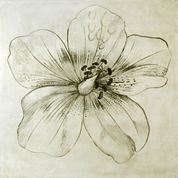News
Covid-19 has changed all our lives. I am thankful that I have remained well, but long to return to normal activities like visiting with friends and family, and travelling for art and pleasure.
While self-isolating in Port Hope I have been working in my studio daily. In 2020 I produced Other Echoes, a collection of works on paper examining home and memory.
Early in 2021 I completed the Canadian part of The Tangled Garden a large, long-term garden wall project. Hopefully in the future I will have the opportunity to travel and develop the imagined two remaining walls.
My annual summer canoe trip with the other artists of the Gibson Girls, was cancelled and our exhibition in Vilnius, Lithuania was postponed until 2022. The mail art exchange project we were to exhibit, Where I'm at Now: A Conversation in Art has continued and provided some solace and connection. Go to our newly launched website gibsongirlsart.com to see the growing collection of collaborative postcards created by the group. Follow our activities and the project on instagram @5gibsongirls.
News
Covid-19 has changed all our lives. I am thankful that I have remained well, but long to return to normal activities like visiting with friends and family, and travelling for art and pleasure.
While self-isolating in Port Hope I have been working in my studio daily. In 2020 I produced Other Echoes, a collection of works on paper examining home and memory.
Early in 2021 I completed the Canadian part of The Tangled Garden a large, long-term garden wall project. Hopefully in the future I will have the opportunity to travel and develop the imagined two remaining walls.
My annual summer canoe trip with the other artists of the Gibson Girls, was cancelled and our exhibition in Vilnius, Lithuania was postponed until 2022. The mail art exchange project we were to exhibit, Where I'm at Now: A Conversation in Art has continued and provided some solace and connection. Go to our newly launched website gibsongirlsart.com to see the growing collection of collaborative postcards created by the group. Follow our activities and the project on instagram @5gibsongirls.
News
Covid-19 has changed all our lives. I am thankful that I have remained well, but long to return to normal activities like visiting with friends and family, and travelling for art and pleasure.
While self-isolating in Port Hope I have been working in my studio daily. In 2020 I produced Other Echoes, a collection of works on paper examining home and memory.
Early in 2021 I completed the Canadian part of The Tangled Garden a large, long-term garden wall project. Hopefully in the future I will have the opportunity to travel and develop the imagined two remaining walls.
My annual summer canoe trip with the other artists of the Gibson Girls, was cancelled and our exhibition in Vilnius, Lithuania was postponed until 2022. The mail art exchange project we were to exhibit, Where I'm at Now: A Conversation in Art has continued and provided some solace and connection. Go to our newly launched website gibsongirlsart.com to see the growing collection of collaborative postcards created by the group. Follow our activities and the project on instagram @5gibsongirls.
Paradise Field
Paradise Field, Loop Gallery, Toronto, 2009.
Paradesha (Sanscrit): foreign country. (para - beyond; desha - land, country)
Paradise Field is a collection that considers how choices are made about those things that surround us. Here an undulating field of traditional looking botanical prints shifts in perspective. Drawn versions of local wildflowers, they collectively re-present an ideal Southern Ontario garden paradise in a soothingly familiar field of information. Each plant is easily named, free of labour, has a history of botanic use, is perennially returning and together bloom continuously throughout our growing season.
All these plants were introduced to Canada. Their names are multiple reminders of someone, somewhere or something else: Royalty (Queen Anne’s Lace, King Cup, King Devil); Gods and Saints (Helenium, Hypericum, Elf wort, St. John’s Wort, St. Joseph’s flower, Maudleyn Daisy): Birds and Beasts (Bird’s Nest, Oxeye Daisy, Hawkweed, Fox-and-cubs, Hive-vine, Horseweed, Crowfoot, Goatweed, Goat’s Beard).
Naturalized into fields and waste places, they carry their history with them but are habitually seen as always here, always ours. What has this paradise replaced? What is included and excluded in this present paradise? Is paradise ever benign? Despite a desire for a singular understanding, a longing for permanence and an ideal return, paradise is always a shifting construct based on a changing field of understanding. And like collections, paradise always refers to someone, something or somewhere else.
Paradise Field, 46x46cm, drypoint on Gampi, editions of 10. $400 each.









